
#Apache tomcat vulnerabilities portable#
When Tomcat was configured to use NIO+OpenSSL or NIO2+OpenSSL for TLS, a specially crafted packet could be used to trigger an infinite loop resulting in a denial of service.Īn out-of-bounds array read in the apr_time_exp*() functions was fixed in the Apache Portable Runtime 1.6.3 release (CVE-2017-12613). This created a memory leak that, over time, could lead to a denial of service via an OutOfMemoryError.Īpache Tomcat 8.5.0 to 8.5.63, 9.0.0-M1 to 9.0.43 and 10.0.0-M1 to 10.0.2 did not properly validate incoming TLS packets.
#Apache tomcat vulnerabilities upgrade#
The object introduced to collect metrics for HTTP upgrade connections was not released for WebSocket connections once the connection was closed. This issue is only exploitable when Tomcat is configured to persist sessions using the FileStore. The fix for bug CVE-2020-9484 introduced a time of check, time of use vulnerability into Apache Tomcat 10.1.0-M1 to 10.1.0-M8, 10.0.0-M5 to 10.0.14, 9.0.35 to 9.0.56 and 8.5.55 to 8.5.73 that allowed a local attacker to perform actions with the privileges of the user that the Tomcat process is using. This could result in subsequent connections using the same object concurrently which could result in data being returned to the wrong use and/or other errors. The error handling triggered in this case could cause the a pooled object to be placed in the pool twice. If a web application sends a WebSocket message concurrently with the WebSocket connection closing when running on Apache Tomcat 8.5.0 to 8.5.75 or Apache Tomcat 9.0.0.M1 to 9.0.20, it is possible that the application will continue to use the socket after it has been closed. While the EncryptInterceptor does provide confidentiality and integrity protection, it does not protect against all risks associated with running over any untrusted network, particularly DoS risks. Upgrade Apache Tomcat to the latest version.The documentation of Apache Tomcat 10.1.0-M1 to 10.1.0-M14, 10.0.0-M1 to 10.0.20, 9.0.13 to 9.0.62 and 8.5.38 to 8.5.78 for the EncryptInterceptor incorrectly stated it enabled Tomcat clustering to run over an untrusted network. This enabled an XSS attack.Īffected Apache Tomcat version (6.0.0 - 6.0.13). The Host Manager Servlet did not filter user supplied data before display.

JSPs within the examples web application did not escape user provided data before including it in the output.



 0 kommentar(er)
0 kommentar(er)
